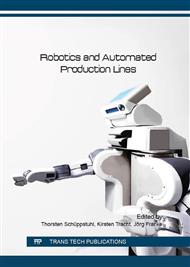[1]
S. Hesse, Industrieroboterpraxis: Automatisierte Handhabung in der Fertigung, Springer, Berlin, (2013).
Google Scholar
[2]
M. Hägele, Aktuelle Innovationen rund um den Einsatz von Robotern, Information online on http: /www. quest-trendmagazin. de/maschinenbau/automatisierung/robotik/interview-fraunhofer-ipa/interview-fraunhofer-ipa-seite-2. html (21. 09. 2015).
Google Scholar
[3]
McKinsey & Company (Ed. ), Zukunftsperspektive deutscher Maschinenbau – Erfolgreich in einem dynamischen Umfeld agieren, Berlin, (2014).
Google Scholar
[4]
K. Scholl, Neue Herausforderungen für die robotergestützte Fertigung, in: ATZ Produktion, Volume 4, No. 4, Springer, Wiesbaden, (2011).
DOI: 10.1365/s35726-011-0059-3
Google Scholar
[5]
G. Litzenberger, Goldene Zeiten für Industrieroboter – Daten, Fakten, Trends und Prognosen zum Weltmarkt für Industrieroboter, Lecture at 4th VDI-Fachtagung Industrielle Robotik, Baden-Baden, (2014).
Google Scholar
[6]
R. Müller, M. Vette, A. Geenen, Potenziale der Mensch-Roboter-Kooperation im Sondermaschinen- und Anlagenbau, Information online on http: /www. handling. de/thema/mensch-roboter-kooperation. htm (21. 09. 2015).
DOI: 10.37544/1436-4980-2015-09-56
Google Scholar
[7]
M. Gundel, Der Leichtbauroboter wird ein Türöffner für uns sein, Information online on http: /www. maschinenmarkt. vogel. de/robotik_robotertechnik/articles/456783/index2. html (21. 09. 2015).
Google Scholar
[8]
M. Weck, C. Almeida, Unscharfe Roboterprogrammierung – Roboter programmieren auf der Basis von ungenauen Angaben, in: wt Werkstatttechnik online, Volume 93, No. 9, Springer, Düsseldorf, (2003).
DOI: 10.37544/1436-4980-2003-9-627
Google Scholar
[9]
M. F. Zäh, W. Vogl, U. Munzert, Beschleunigte Programmierung von Industrierobotern – Augmented-Reality-Einsatz zur intuitiven Mensch-Maschine-Interaktion, in: wt Werkstatttechnik online, Volume 94, No. 9, Springer, Düsseldorf, (2004).
DOI: 10.37544/1436-4980-2004-9-438
Google Scholar
[10]
C. Meyer, Eine neue Generation von Robotern, in: wt Werkstatttechnik online, Volume 98, No. 9, Springer, Düsseldorf, (2008).
DOI: 10.37544/1436-4980-2008-9-752
Google Scholar
[11]
C. Brecher, et al., Roboterprogrammierung durch Demonstration – Ein ganzheitliches Verfahren zur intuitiven Erzeugung und Optimierung von Roboterprogrammen, in: wt Werkstatttechnik online, Volume 99, No. 9, Springer, Düsseldorf, (2009).
Google Scholar
[12]
C. Brecher, et al., Intuitive Roboterprogrammierung in der automatisierten Montage – Ein hybrides Verfahren zur Programmierung durch direkte Interaktion, in: wt Werkstatttechnik online, Volume 100, No. 9, Springer, Düsseldorf, (2010).
DOI: 10.37544/1436-4980-2010-9-681
Google Scholar
[13]
E. Uhlmann, T. Friedrich, Programmier- und Steuerungssystem für Industrieroboter in der flexiblen Fertigung – Wissenschaftliche Nutzung von Industrierobotern in der Kleinserien- und Einzelfertigung, in: wt Werkstatttechnik online, Volume 100, No. 5, Springer, Düsseldorf, (2010).
DOI: 10.37544/1436-4980-2010-5-407
Google Scholar
[14]
R. Müller, et al., Eine modellbasierte Steuerungsarchitektur ermöglicht die schnelle Rekonfiguration von Montagevorrichtungen und Assistenz bei der Mensch-Roboter-Kollaboration, in: VDI-Mechatronik, No. 11, VDI Verlag, Dortmund, (2015).
Google Scholar
[15]
R. Müller, M. Vette, S. Quinders, Handhabung großer Bauteile zur Flugzeugmontage mittels eines Verbunds kinematischer Einheiten unterschiedlicher Struktur, in: VDI-Bewegungstechnik, No. 2175, VDI Verlag, Aachen, (2012).
Google Scholar


